PATUALAKHALI: Residents in low-lying areas of Bangladesh and India surveyed the damage on Monday as a cyclone that slammed into the coast weakened into a powerful storm after killing at least 10 people and destroying thousands of homes.
Cyclone Lemal made landfall on Sunday night, bringing fierce winds and rough seas to coastal areas.
The winds had died down by Monday afternoon but residents were still braving the elements as they picked through the remains of their homes.
An AFP journalist in the affected areas said villages were flooded by the storm surge, tin roofs were torn off, trees were uprooted and power lines were downed.
“Heavy rains from the cyclone are continuing and wind speeds are high,” said Shaukat Ali, district administrator of Barisal, where seven people were killed.
“Most of them died after being crushed by collapsed houses or fallen walls,” he told AFP.
Three other people died in nearby areas, including from drowning.
Cyclones have killed hundreds of thousands of people in Bangladesh in recent decades, but climate change has meant the number of superstorms hitting the densely populated coastal areas has jumped from one to three times a year.
Two people were killed in Klang district, government administrator Helal Mahmoud told AFP.
“The cyclone has affected over 1,23,000 houses in the division, of which around 31,000 have been completely destroyed,” he said.
Remal’s peak wind speeds reached 111 kilometres per hour, said Muhammad Abul Kalam Malik, senior weather forecaster at the state-run Bangladesh Meteorological Department.
Scientists say climate change is causing an increase in storms, but more accurate forecasts and more effective evacuation plans have dramatically reduced the death toll.
About one million people in Bangladesh and neighbouring India fled inland to concrete shelters to escape the dangerous waves.
Most of Bangladesh’s coastal areas are only 1 to 2 meters (3 to 6 feet) above sea level, making them vulnerable to storm surges.
Smita Mondal, 36, who had been hiding out overnight off the Indian coast, said she fled with only what she could carry.
“My three-year-old son is crying for food,” she told AFP by telephone.
“Several embankments have collapsed or been flooded, causing flooding in parts of the coast,” said Kamrul Hasan, head of Bangladesh’s Ministry of Disaster Management.
In the Indian state of West Bengal, the cyclone “blew off roofs from hundreds of houses” and “uprooted thousands of mangrove trees and electricity poles”, state government official Bankim Chandra Hazra told AFP.
“Many embankments have collapsed due to high tides and rising sea levels,” Hazra added. “Villages on the island are flooded.”
At least 800,000 Bangladeshis have fled, and more than 150,000 people in India have been relocated inland from the vast mangrove forests of the Sundarbans, where the Ganges, Brahmaputra and Meghna rivers flow into the sea.
Malik, a Bangladeshi weather expert, said vast mangrove forests helped cushion the worst of the storm’s impacts.
“As in the past, the Sundarbans acted as a natural shield against cyclones,” he said.
But Abu Naser Mohsin Hossain, a senior forest officer with Bangladesh’s Sundarbans Forest Division, said the high tide had caused important freshwater bodies to become inundated with salt water.
“We are worried,” Hossain said. “These ponds were a source of fresh water for all the wildlife in the mangrove forest, including the endangered Bengal tiger.”

